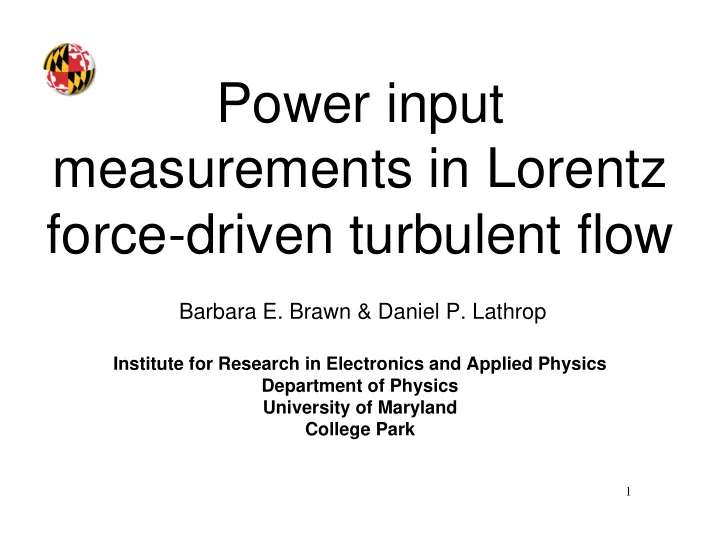

Power input measurements in Lorentz force-driven turbulent flow Barbara E. Brawn & Daniel P. Lathrop Institute for Research in Electronics and Applied Physics Department of Physics University of Maryland College Park 1
Goals • measure local velocity in a flow driven by known Lorentz forces �� � � � � � = ρ × F J B L • use velocity measurements to yield local power input � �� = ⋅ P u F • correspondence to steady-state Fluctuation Theorem? 1 Pr( ) P = lim lnPr( P τ − τ →∞ ) P 2
3 Experimental Set Up Electrode Configurations Quadrupole Cu Cu Cu Cu Dipole Na
Lorentz Force N o rm a liz e d F itte d F u n c tio n s , D ip o le 2 . 6 Dipole J (x ) (a m p s ) B (x ) (g a u s s ) 2 . 4 F L (x ) (N e w t o n s ) 2 . 2 2 1 . 8 1 . 6 1 . 4 1 . 2 1 0 . 8 -1 -0 .8 -0 .6 -0 .4 -0 .2 0 0 .2 0 .4 0 .6 0 .8 1 x N o rm a liz e d F itte d F u n c tio n s , Q u a d ru p o le 2 Quadrupole J (x ) (a m p s ) B (x ) (g a u s s ) 1 .5 F L (x ) (N e w to n s ) 1 0 .5 0 -0 .5 -1 -1 .5 -2 -1 -0 .8 -0 .6 -0 .4 -0 .2 0 0 .2 0 .4 0 .6 0 .8 1 x 4
t B Field Vs Mean Velocity 5 mean velocity (cm/s) Velocity Profiles v (cm/s) t t (s) Quadrupole Dipole x (cm)
Dipole Power 10 A 300 G Power vs. Pr ( P ) Probability Distribution Pr( -P ) / Pr( P ) Pr ( P ) P (W) 6
Continuing Power Analysis P (x ) P (x ) D ip o le , 2 0 A m p s, 3 0 0 G a u s s D ip o le , 3 0 A m p s , 3 0 0 G a u s s 0 .0 6 0 .0 8 0 .0 7 0 .0 5 0 .0 6 0 .0 4 0 .0 5 0 .0 3 0 .0 4 Power Power 0 .0 3 0 .0 2 0 .0 2 0 .0 1 0 .0 1 0 0 -0 .0 1 -0 .0 1 -1 -0 .8 -0 .6 -0 .4 -0 .2 0 0 .2 0 .4 0 .6 0 .8 1 -1 -0 .8 -0 .6 -0 .4 -0 .2 0 0 .2 0 .4 0 .6 0 .8 1 x x 7
Summary • Turbulent flow from body force Reynolds number Re=1.5 � 10 4 , where Re=(v max D)/ ν ( Na kinematic viscosity ν = 0.008 cm 2 /s) Schumacher and Eckhardt, PHYSICA D-NONLINEAR PHENOMENA 187 (1-4): 370-376 JAN 1 2004 • Fluctuation Theorem holds outside standard context (local vs. global power) Mazonka and Jarzynski, ARXIV:COND-MAT/9912121 V1: 7 DEC 1999 8
Recommend
More recommend